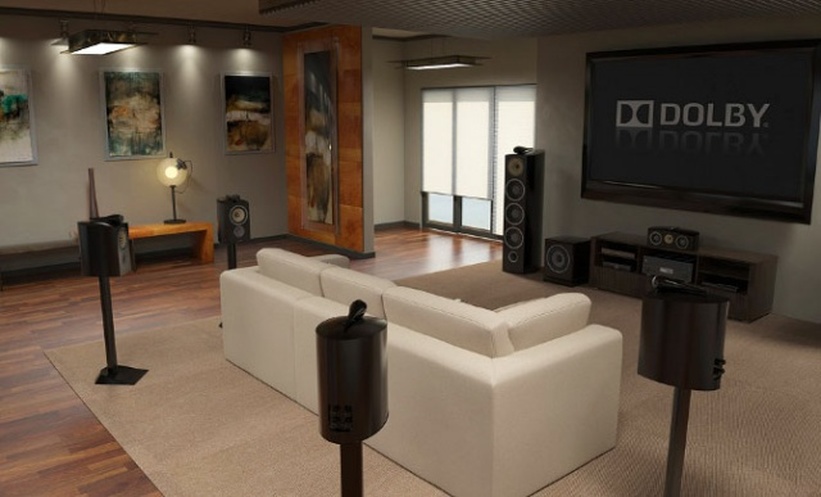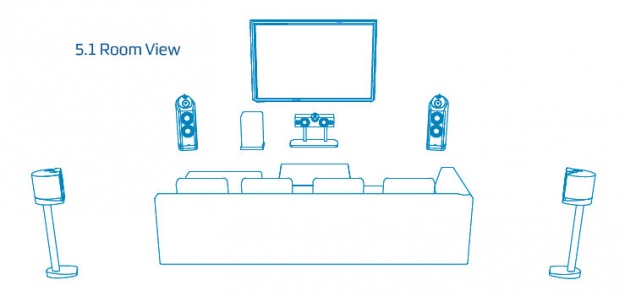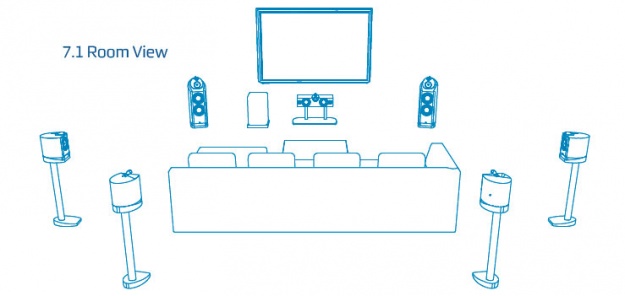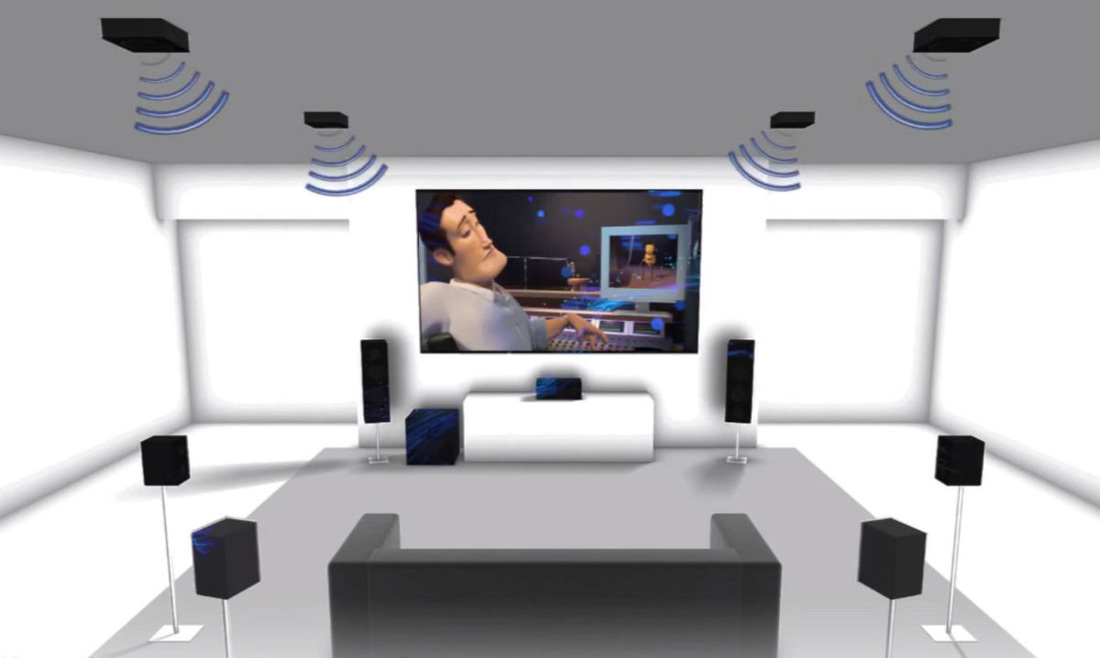Surround Receivers
A home theater receiver is the key to truly immersive, movie
theater-like entertainment at home. In addition to providing
impressively detailed surround sound, today’s receivers act as a
connection hub for a huge variety of audio/video sources. We at Team Electronics are committed to matching just the right amount of technology to your lifestyle and budget. Please find our quick Home theater Guide below to answer your basic questions, or stop in our Manitowoc Showroom and we will answer all the questions you may have.
Image courtesy of Dolby
DTS: The rival What’s a technology market without a little competition? Up to a point, Dolby more or less dominated the surround-sound landscape. Then, in 1993, DTS came along. DTS, which stands for Digital Theater Systems, is another company providing digital surround sound mixing services for movie production. DTS surround sound was first heard in theaters with Jurassic Park. The technology eventually trickled down to LD and DVD, but was initially available on a very limited selection of discs. DTS utilizes a higher bitrate and, therefore, delivers more audio information. Think of it as similar to the difference between listening to a 256kbps and 320kbps MP3 file. The quality difference is noticeable, but according to some, negligible.
6.1: Kicking it up a notch: In an effort to enhance surround sound by expanding the “sound stage,” the addition of a sixth speaker to the original 5.1 configuration brought about 6.1. This sixth speaker was to be placed in the center of the back of a room and was subsequently referred to as a back surround or rear surround. This is where a lot of confusion began to swirl around surround sound. People were already used to thinking of and referring to surround speakers (incorrectly) as “rears,” because they were so often seen placed behind a seating area. Recommended speaker placement, however, has always called for surround speakers to be placed to the side and just behind the listening position. The point of this speaker is to give the listener the impression that something is approaching from behind or disappearing to the rear. It pulls off with more success what the side surrounds attempted to do by working together to fool the ear. Calling the sixth speaker a “back surround” or “surround back” speaker, while technically an accurate description, ended up being just plain confusing.
To make things even more confusing Dolby Digital/THX and DTS offered different 6.1versions. Dolby Digital and THX collaborated to create a version that is referred to as “EX” or “surround EX.” Information for the speaker is matrix encoded into the left and right surround speakers. DTS, on the other hand, offered two different 6.1 versions. DTS-ES Discrete and DTS-ES Matrix performed as their names suggested. With ES Discrete, specific sound information has been programmed onto a DVD or Blu-ray disc, rather than simply extrapolating information from the surround channels.
7.1: The spawn of Blu-ray As is often the case in the world of electronics, just when you decide to bite the bullet and buy a new piece of equipment, something new comes out that leaves your shiny new gear in the dust. Such was the case when 7.1 audio was introduced in conjunction with the HD-DVD and Blu-ray discs. Just when people started getting used to 6.1, 7.1 came along as the new must-have surround format.
Like 6.1, there are several different versions of 7.1. All of them add in a second back surround speaker. Those surround effects that once went to just one rear surround speaker can now go to two speakers which happen to be in stereo, too. The information is discrete, which means that every speaker is getting its own specific information. We can thank the massive storage potential of Blu-ray for that.
Dolby offers two different 7.1 surround versions. Dolby Digital Plus is the “lossy” version which, still involves data compression and takes up less space on a Blu-ray disc. Dolby TrueHD, on the other hand, is lossless. Since no compression is involved, Dolby TrueHD is intended to be identical to the studio master.
Image courtesy of Dolby
DTS also has two 7.1 versions, which differ in the same manner as Dolby’s versions. DTS-HD is a lossy, compressed 7.1 surround format, whereas DTS-Master HD is lossless and meant to be identical to the studio master.
It is important to note here that 7.1-channel surround mixes are not always included on Blu-ray discs. Movie studios have to opt to mix for 7.1, and don’t always do so. There are other factors involved too. Storage space is chief amongst them. If a bunch of extras are placed on a disc, there may not be space for the additional surround information.
In many cases, a 5.1 mix can be expanded to 7.1 by a matrix process in an A/V receiver. This way, those back surround speakers get used, even if they don’t get discrete information.
9.1: Pro Logic makes a comeback If you’ve been shopping for a receiver, you may have noticed that many offer one or more different versions of Pro Logic processing. In the modern Pro Logic family, we now have Pro Logic II, Pro Logic IIx and Pro Logic IIz. Let’s take a look at what each of them does.
Pro Logic II is most like its early Pro Logic predecessor in that it can make 5.1 surround sound out of a stereo source. The difference is Pro Logic II provides stereo surround information. This processing mode is commonly used when watching non-HD TV channels with a stereo audio mix.
Pro Logic IIx is one of those processing modes we mentioned that can take a 5.1 surround mix and expand it to 6.1 or 7.1. Pro Logic IIx is subdivided into a movie, music and game mode.
Pro Logic IIz allows the addition of two “front height” speakers that are placed above and between the main stereo speakers. This form of matrix processing aims to add more depth and space to a soundtrack by outputting sounds from a whole new location in the room. Since IIz processing can be engaged with a 7.1 soundtrack, the resulting format could be called 9.1.
Audyssey DSX: A lesson in one-upmanship Audyssey, a company best known for its auto-calibration software found in many of today’s A/V receivers, has released Audyssey DSX, which also allows for additional speakers beyond the core 5.1 and 7.1 surround formats. With the addition of front width and front height channels on top of a 7.1 system, it is possible to achieve up to 11.1 channels of surround sound.
AVR flavors of surround: The Malt-O-Meal of surround Some receiver manufacturers, rather than purchase the rights and processors for Dolby or Audyssey’s products, are making their own versions of surround-sound expansion. Since this is a developing segment, we’re not going to get into this topic much further than to say that those interested should check with one of our technicians and we will be happy to get you your answers.
What about 7.2, 9.2 or 11.2? As we mentioned previously, the “.1” in 5.1, 7.1 and all the others refers to the LFE (low frequency effects) channel in a surround soundtrack, which is handled by a subwoofer. Adding “.2” simply means that a receiver has two subwoofer outputs. Both connections put out the same information since, as far as Dolby and DTS are concerned, there is only one subwoofer track. Since A/V receiver manufacturers want to easily market the additional subwoofer output, the notion of using “.2” was adopted.
Dolby Atmos: The future Dolby Atmos is the newest thing in surround sound, far exceeding the capabilities of surround as we’ve come to know it. Unlike Dolby Digital, Atmos can process 128 channels of sound (compared to, say, 8 channels for Dolby Digital 7.1) that can be routed to up to 64 speakers. That alone is impressive, but the real magic comes in the fact that a filmmaker can isolate individual speakers to produce a specific sound. In the past, if there was an explosion on the right of the screen, half of the theater would have the same sound. Now, each individual speaker can present its own sound, anywhere in the theater, even on the ceiling. This allows for a more realistic and immersive movie-going experience. The technology premiered in 2012 with Pixar’s Brave.
DTS also has two 7.1 versions, which differ in the same manner as Dolby’s versions. DTS-HD is a lossy, compressed 7.1 surround format, whereas DTS-Master HD is lossless and meant to be identical to the studio master.
It is important to note here that 7.1-channel surround mixes are not always included on Blu-ray discs. Movie studios have to opt to mix for 7.1, and don’t always do so. There are other factors involved too. Storage space is chief amongst them. If a bunch of extras are placed on a disc, there may not be space for the additional surround information.
In many cases, a 5.1 mix can be expanded to 7.1 by a matrix process in an A/V receiver. This way, those back surround speakers get used, even if they don’t get discrete information.
9.1: Pro Logic makes a comeback If you’ve been shopping for a receiver, you may have noticed that many offer one or more different versions of Pro Logic processing. In the modern Pro Logic family, we now have Pro Logic II, Pro Logic IIx and Pro Logic IIz. Let’s take a look at what each of them does.
Pro Logic II is most like its early Pro Logic predecessor in that it can make 5.1 surround sound out of a stereo source. The difference is Pro Logic II provides stereo surround information. This processing mode is commonly used when watching non-HD TV channels with a stereo audio mix.
Pro Logic IIx is one of those processing modes we mentioned that can take a 5.1 surround mix and expand it to 6.1 or 7.1. Pro Logic IIx is subdivided into a movie, music and game mode.
Pro Logic IIz allows the addition of two “front height” speakers that are placed above and between the main stereo speakers. This form of matrix processing aims to add more depth and space to a soundtrack by outputting sounds from a whole new location in the room. Since IIz processing can be engaged with a 7.1 soundtrack, the resulting format could be called 9.1.
Audyssey DSX: A lesson in one-upmanship Audyssey, a company best known for its auto-calibration software found in many of today’s A/V receivers, has released Audyssey DSX, which also allows for additional speakers beyond the core 5.1 and 7.1 surround formats. With the addition of front width and front height channels on top of a 7.1 system, it is possible to achieve up to 11.1 channels of surround sound.
AVR flavors of surround: The Malt-O-Meal of surround Some receiver manufacturers, rather than purchase the rights and processors for Dolby or Audyssey’s products, are making their own versions of surround-sound expansion. Since this is a developing segment, we’re not going to get into this topic much further than to say that those interested should check with one of our technicians and we will be happy to get you your answers.
What about 7.2, 9.2 or 11.2? As we mentioned previously, the “.1” in 5.1, 7.1 and all the others refers to the LFE (low frequency effects) channel in a surround soundtrack, which is handled by a subwoofer. Adding “.2” simply means that a receiver has two subwoofer outputs. Both connections put out the same information since, as far as Dolby and DTS are concerned, there is only one subwoofer track. Since A/V receiver manufacturers want to easily market the additional subwoofer output, the notion of using “.2” was adopted.
Dolby Atmos: The future Dolby Atmos is the newest thing in surround sound, far exceeding the capabilities of surround as we’ve come to know it. Unlike Dolby Digital, Atmos can process 128 channels of sound (compared to, say, 8 channels for Dolby Digital 7.1) that can be routed to up to 64 speakers. That alone is impressive, but the real magic comes in the fact that a filmmaker can isolate individual speakers to produce a specific sound. In the past, if there was an explosion on the right of the screen, half of the theater would have the same sound. Now, each individual speaker can present its own sound, anywhere in the theater, even on the ceiling. This allows for a more realistic and immersive movie-going experience. The technology premiered in 2012 with Pixar’s Brave.





